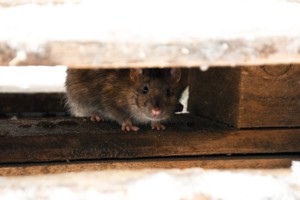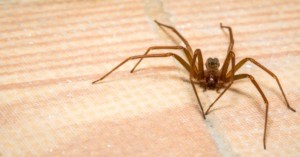When winter comes down and drapes the land in snow, it enfolds the grass and flowers, plants and trees, packing them away until spring warms the earth once more. And, of course, it also banishes away everyday pests, the cold keeping them locked in hibernation and far from your property — right?
Well, not so much. Winter bugs and mammals often stay very active during the frosty months, and that means that you may very well need to consider pest control even as the proverbial mercury plunges. In this article, we’ll discuss some of the common pests you can expect to encounter during the winter, as well as how they commonly gain access to your home or business.
Ants
Sometimes people ask us, “What bugs die in winter?” The answer is, “It depends!” Some insects perish rather quickly, while others prove particularly hardy, even against the cold. Ants will usually perish as the temperature drops below 15° Fahrenheit, but many species of ant prove hardier, synthesizing glycerol to avoid dying during cold periods. Other kinds of ants, such as winged carpenter ants, may have established nests prior to winter and could be drawn into your comparatively warmer property.
Beetles
Various kinds of beetles, such stinkbugs, lack the cold resistance of ants and may migrate into your property as the temperature falls. They gain access in a number of different ways, one of the most common being overwintering (i.e., entering prior to winter and seeking to use your shelter as its own). They also will take advantage of entry points such as cracks in the walls, missing weather stripping, or spaces around pipes. They may also hitchhike their way in on plants or packages.
Norway Rats

Norway rats are one of the most common kinds of rodents found in the United States, and they have the uncanny ability to squeeze themselves through incredibly tiny spaces. Generally accepted wisdom holds that they can take advantage of holes smaller than an inch in diameter, and National Geographic has provided a demonstration of how rats can make their way into a property through a toilet. Keep the lid down, and make sure that you patch exterior holes.
Ladybugs
Ladybugs are a kind of beetle, as is the Asian lady beetle, which bears a close resemblance to it, so the same general tips that apply to beetles will work with them. Fortunately, ladybugs pose much less of a risk than other pests. They won’t damage a building or spoil clothing or furnishings. However, they can emit an unpleasant odor, and their blood may stain, so take care when disposing of them.
Silverfish
With their odd appearance, preference for darkness, and tendency to scurry for cover as soon as they’re discovered, silverfish can prove an unpleasant surprise. They’re not incredibly damaging insects, but they prefer to eat starchy materials, which means that they can spoil cardboard, foodstuffs, reading materials, linens, clothing, furniture, and more. Silverfish also prefer cool temperatures and damp spaces, so expect more of them during winter.
German Cockroaches
Cockroaches are some of the hardiest creatures on the planet, having tough exoskeletons, quick reproductive cycles, the ability to survive for long periods without sustenance, and even a degree of resistance to radiation. All of this means that they can survive just about anywhere — including during wintertime. Puzzling out just how cockroaches manage to gain access to property can be a challenge. All species of cockroach (including German cockroaches, which is the kind you’ll most likely encounter during cold months) can hitchhike in on packages or squeeze in through small cracks. Eliminating clutter and food waste will go a long way toward managing them.
Brown Recluse Spiders
There are only two kinds of spider in the continental United States that pose a serious danger to people, and the one you’re most likely to encounter during the winter is the brown recluse. True to its name, this arachnid likes to secret itself away in undisturbed places. The best way to manage them is to bag unused pieces of clothing so that they don’t become a home for this potentially deadly little creature. Keeping trees and bushes trimmed back from your structure also helps.
Ticks
Good news: Many kinds of ticks will enter a dormant state during winter. Bad news: Deer ticks are one of those insects that live in cold climates, and they may manage to make it into your home. The main way that they migrate is by attaching themselves to pets when they’ve gone outside to walk. One of the best tests you can do for ticks should be attempted prior to the mercury beginning to fall. Tying a cloth to a stick and dragging it through your yard stands a good chance of picking up ticks if they’re present around the property. If this test turns up these irritating insects, you’ll want to contact a pest control professional to eliminate them.
Boxelder
The boxelder bug — which is a true type of bug since it belongs to the order Hemiptera — primarily lives in the maple, ash, and boxelder trees, hence its name. However, they also seek out warm places where they can overwinter and that might include your home or office. They aren’t particularly dangerous or damaging, although they can stain items if they happen to get squashed. Ensuring that any trees remain trimmed and don’t touch your buildings can help prevent them.
Cluster Fly
Flies are a common irritant during the summer months, and many attempt to control them due to the human health risks that their egg-laying behavior poses. Fortunately, cluster flies are a different species than bluebottle flies and won’t hurt people. Unfortunately, they migrate toward warmth en masse during winter, meaning that they may swarm your home, offices, or storage areas without warning.
If you find yourself facing an infestation during the winter or any other time of the year, contact us here at Smithereen Pest Management Services. As a Green Shield Certified company, we know how to eliminate pests in a way that protects both people and the environment.
